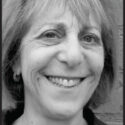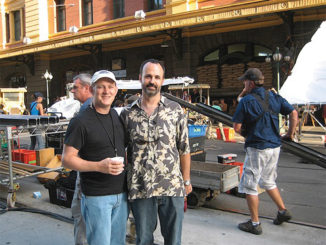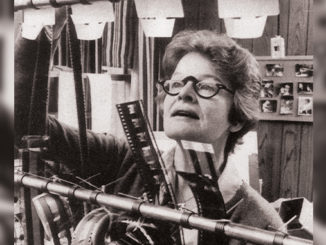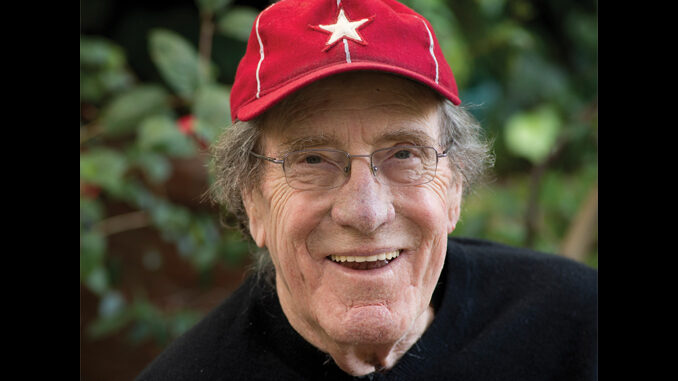
by Debra Kaufman • portrait by Martin Cohen
Robert C. Jones grew up in the film industry; his father, Harmon Jones, was a feature film editor (Gentleman’s Agreement, Panic in the Streets, among others) and later TV director (Rawhide, Perry Mason and Death Valley Days). Jones didn’t aspire toward a career as an editor, but fell into it, starting with a job in the shipping room at 20th Century-Fox. “I grabbed it without knowing what I was getting into,” he admits. The shipping room led to the blooping room, then to the coding room and, finally, to the editing room, as an apprentice. “That was magic to me,” he recalls. “It opened my eyes to what my dad had done.”
Early in his career, Jones worked as an apprentice and then assistant editor on several movies; the best, he said, was The Long Hot Summer (1958), on which he was an assistant. In the midst of working through the eight years he needed (at the time) to become an editor, Jones was drafted and sent to the Army Pictorial Center located at what is now Kaufman Astoria Studios in New York. “I was so fortunate,” says Jones. “They made me an editor right away. I was making documentaries and training films, and I got a lot of experience and confidence doing that.”
After a career working with directors such as Stanley Kramer, Arthur Hiller, Hal Ashby and Warren Beatty, Jones retired from editing in 2001, and began teaching the craft at USC’s School of Cinematic Arts. The Jones family’s involvement with feature film editing is ongoing: His daughter Leslie Jones (The Master) is now the family’s third generation to work in the movies.
Jones called his selection to receive an ACE Career Achievement Award — which was presented at the American Cinema Editors’ 64th annual Eddie Awards on February 7 — “unexpected,” and said it “feels great.”
CineMontage interviewed Jones in January.
CineMontage: How did you initially get into editing? Did you want to follow in your father’s footsteps?
Robert C. Jones: No. I went to college but dropped out after a few weeks, and just happened to get a job in the studio. I started in the shipping room, carrying film all over the place. Then I got promoted to the looping room, where there was a spray system with which we’d paint over splices so they didn’t pop. That was a horrible job, breathing these fumes all day long. From there, I went to the numbers room, where we’d number the dailies so the editor could keep the sound and picture in sync. I had a lot of fun doing all these different tasks. I did get promoted pretty quickly to work as an apprentice. I believe the first editor I apprenticed for was Barbara McLean on Untamed (1955) with Tyrone Power and Susan Hayward. What a great editor she was.
“Going through the first cut, I concentrate on performances and honesty. Then I’ll think of story. The scripts I write are also character-based and not so much plot-driven.”
CM: When you got back from the Army, how did you get back into film editing?
RCJ: Back in Hollywood, the old studio system was breaking down. I got an offer from 20th Century-Fox to work in TV, but I didn’t want to work in TV so I turned it down. That afternoon, I had a call from the editor Gene Fowler, Jr. for a new job with John Cassavetes directing, and I hired on as the assistant on A Child Is Waiting [1963].
I think A Child is Waiting was my breakthrough. I loved working with Cassavetes and I learned never to give up on something no matter how crazy it sounds. Even though It’s a Mad, Mad, Mad, Mad World [1963] now seems more daunting, I got a lot from working with Cassavetes on A ChildIsWaiting. Later, they asked me to do Faces. I went to his garage where they were working, and saw it was packed with 16mm film. It looked like a two- or three-year job, so I said no.
CM: It’s a Mad, Mad, Mad, Mad World was an iconic film with so many incredible comedic actors. How did you get on that job and what was this experience like?
RCJ: Stanley Kramer produced A Child Is Waiting, and we were working right next door to where they were editing It’s a Mad, Mad, Mad, Mad World. Gene Fowler, the editor I was working with, was brought on to edit the climax, and they asked me to come with him. But they wanted me to drop back down to assistant, so I declined. I left, and two weeks later I got a call to come back as the third editor. So it was good I said no the first time. Then the lead editor became ill and he couldn’t continue working on it. Gene finished the climax sequence and they let him go. I was the only one on it and I was a neophyte editor, 26 or 27 at the time. There was so much amazing stuff — the dailies no one saw. It was a huge responsibility, but it was great.
At the time, it had scared me to say, “No, I don’t want the job.” I’d just gotten married not too long before this happened. My wife didn’t really understand the film industry, so it really scared her too. But when they called me back two weeks later and offered me the good job, I saw it as a terrific breakthrough.
Then getting the Academy Award nomination for editing was a big break. Along with people like Hal Ashby, Richard Halsey and Donn Cambern, I was a hot young editor for a time!
“My goal was to be a full-time screenwriter. I started working on scripts for name actors, but they’d go for six, eight months and nothing would happen but more rewrites. I got really sick of that and realized I had more creative freedom as an editor than as a writer.”
CM: You’ve worked more than once for several different directors: Stanley Kramer, Arthur Hiller, Hal Ashby and Warren Beatty come to mind. Talk about your relationship with each of them.
RJC: Tobruk [1967] was the first film I did for Arthur. I was hired after he’d gone on location, so I didn’t see him until he finished filming. He was very happy with the first cut, and after that he gave me freedom to do whatever I wanted — with his okay of course. Working with Arthur was wonderful. He was very supportive of my creativity, very trusting and understanding. And he had confidence in me.
Stanley was a classic filmmaker and I learned a lot from him. He didn’t do anything without being thoroughly prepped; Stanley was very conservative when it came to shooting, but he made important liberal films.
Hal shot The Last Detail [1973] on location and when the editor edited the first day’s dailies, Hal fired him, and they hired me when they were finished shooting. I hadn’t wanted to work with him because I heard he was a maniac who worked 24 hours a day. They convinced me to look at dailies and I loved them. Hal and I got along great, and he stuck to my hours, not 24 hours a day. We entered a terrific creative relationship.
When I read the script for Bulworth [1998], I had to do it. I couldn’t believe a major studio was doing it. I had an old homemade computer with funky software and edited on set, tied into video assist. Before, when Warren and I worked on Love Affair [1994], I was in a trailer on the set, and every 10 minutes someone would knock on the door. On Bulworth, I had to stay within 75 feet of video assist; the cable was my umbilical cord.
But working all night — sometimes editing with a crew of 100 people around instead of a quiet cutting room — was quite a task. It was both invigorating and irritating. It was my assistant Ellie Brooks’ first film as a first assistant and she was going going through the wringer trying to get dailies read and the film conformed. She really killed herself working on that thing.
Beatty was very demanding; I had a really good strong creative relationship with him and we were terrific collaborators, back and forth. It was a wonderful experience — but I don’t think I’d want to do it again.
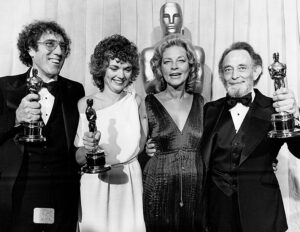
CM: Editing is often described as the final time the story is written. You have also been a writer; tell me about how you developed this career path simultaneously with being an editor?
RJC: I was editing a film that just did not work at all. I asked the director if he minded going away for a couple weeks, and I re-cut it and restructured it and worked on performances. He came back and said, “Have you ever thought about being a writer? You just rewrote my film with editing.” A light bulb went off in my head and I started writing. I learned about writing from editing.
I got a call from Hal about editing a film, which became Coming Home [1978], but I didn’t want to; I was writing something. Two months before shooting, the screenwriter Waldo Salt had a heart attack and couldn’t continue, so Hal asked me to come on. Waldo had done about a year of research on vets, which was good because I had no time to do anything but start writing. I was on that all through shooting, and that was in the days of typewriters, not computers. It shocked me big time to get an Oscar. When I went on the stage to accept it with Waldo and the story’s author Nancy Dowd, it was the first time I met them.
CM: Were you in demand as screenwriter after that?
RJC: After Coming Home, I kept getting Vietnam stories and that wasn’t me. Being There [1979] was more my kind of story, but I didn’t get credit for it. I think my writing career would have been a whole lot different if I had gotten screen credit. The studio had given me co-credit with author Jerzy Kosinski, but the Writers Guild ruled the other way. It was a dark day in my life.
My goal was to be a full-time screenwriter. I started working on scripts for name actors, but they’d go for six, eight months and nothing would happen but more rewrites. I got really sick of that and realized I had more creative freedom as an editor than as a writer.
CM: What is it like teaching editing at USC’s School of Cinematic Arts?
RJC: I love teaching there. Seeing these students “get it” is really fulfilling to me, more than screening a film I’ve worked on. I really have a close relationship with most of the students I teach. I’m not that big on school politics and that kind of thing, but I do feel close to the students. They think I know what I’m talking about. They’ll find me out — that’s everyone’s fear in Hollywood.
CM: What do you consider to be your biggest strengths as an editor?
RJC: I think it’s developing relationships and characters. I have the feeling that if the actors are appealing enough, the story will come out somehow. Going through the first cut, I concentrate on performances and honesty. Then I’ll think of story. The scripts I write are also character-based and not so much plot-driven.
CM: It sounds like you’ve had a lot of fulfilling relationships with directors throughout your career.
RJC: I respect what they do too. Most of the directors really turned on to the way I work. One director paid me a compliment that I keep remembering; he said, “Bob, I don’t always like what you do, but everything you do makes me think.” That’s what I want to do in my life: Make people think.


